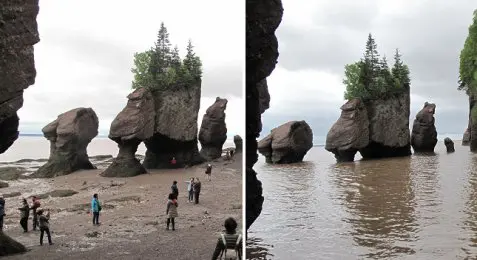[Originally published as Tides at the Bay of Fundy]
Since I had read about them, I wanted to see the tides at the Bay of Fundy, which are the largest in the world. When I mentioned this to one of the organizers of the Canadian homeschool convention at which I spoke, she suggested that we visit Hopewell Cape, which has rocks that erosion has carved into some interesting shapes. She said it was also a great place to see the tides, and she was right!
On the left side of the picture above, you see some of those rocks as they appear at low tide. Notice the people walking around the rocks. In fact, if you look very closely, you will see a spot of red in front of the biggest rock formation. It has a white blotch above it. That’s me in my red jacket and gray hair. On the right, you see the same rock formations at high tide. There’s a big difference, isn’t there?
The Bay of Fundy experiences the largest difference between high and low tide of any place in the world. On most coastlines, the difference between high and low tide is noticeable, but not dramatic. In the Gulf of Mexico, for example, it is about 0.5 meters. On the coast of Southern Africa, it is about 1.6 meters.1 However, the difference between high tide and low tide in the Bay of Fundy can be more than 15 meters!2 That’s why the pictures above are so interesting, at least to nerds like me.
But why does the Bay of Fundy experience such incredible tides?
I am glad you asked!
First, you need to know that the tides are primarily caused by the moon. Without the moon, the seas would form a roughly spherical shape around the earth. However, the moon’s gravitational pull and the relative motion between the earth and moon distort that sphere, turning it into an oval. The earth is at the center of the oval, so there is a “bulge” of water towards the moon and a “bulge” of water directly away from the moon.
As the earth rotates, it brings coastal areas into the bulge, and that’s a high tide. As those coastal areas are moved out of the bulge by the earth’s rotation, they experience low tide. The sun’s gravity plays a role as well, but it is not as important as the moon. Here is a great NOVA interactive animation that explains this in detail.
If that were the end of the story, of course, there would be little (if any) difference between the height of the tides at different places on the earth. However, there are two effects that enhance the tides at the Bay of Fundy. One effect is caused by the bay’s shape. It is shallow, narrow, and long, but it opens into a very deep ocean. As the tide comes in, a lot of water from the deep ocean gets pushed into a relatively small area. As a result, the water tends to “pile up,” enhancing the effect of high tide.
I understood this effect before I visited the bay, but while there, I learned of the other effect, which is probably more important.
Think about a bathtub full of water. If you drop something large into one side of the tub, you will see waves travel along the surface, hit the other end of the tub, and then come back to where they started. The time it takes for them to do that is called the period of the motion. Each bathtub would have a different period, depending on its length and depth. Now think of the Bay of Fundy as a really big bathtub. Its period is about 12 hours, which is roughly equal to the time between the two high tides of the day.
Because the period of the bay is roughly equal to the time between high tides, a resonance is set up. As water is naturally leaving the bay, it gets pushed back into the bay by the incoming tide. Imagine a child on a swing. When is the best time to push the child? Just as the swing reaches its highest altitude and starts to fall again. If you continue to push the child at that point, the swing will go the highest. In the same way, the water rises so high in the bay because the tides are pushing it back into the bay at exactly the right point.3
I had no idea such resonances could be set up by the tides, and even when it was explained to me by the nice tour guide to whom I spoke, I assumed it had to be a minor effect. However, when I started doing some reading on it, most sources (like the one in reference 3) suggest it is the main reason the Bay of Fundy has such high tides.
God’s creation continues to amaze me!
References
- Encyclopedia of Coastal Science, M. Schwartz, ed., Springer 2005, p. 956
- Paul R. Pinet, Invitation to Oceanography, Jones and Bartlett Learning 2013, p. 267
- James T. Shipman, Jerry D. Wilson, and Aaron W. Todd, Introduction to Physical Science, 12th Edition, Brooks/Cole Cengage Learning 209, p. 685






